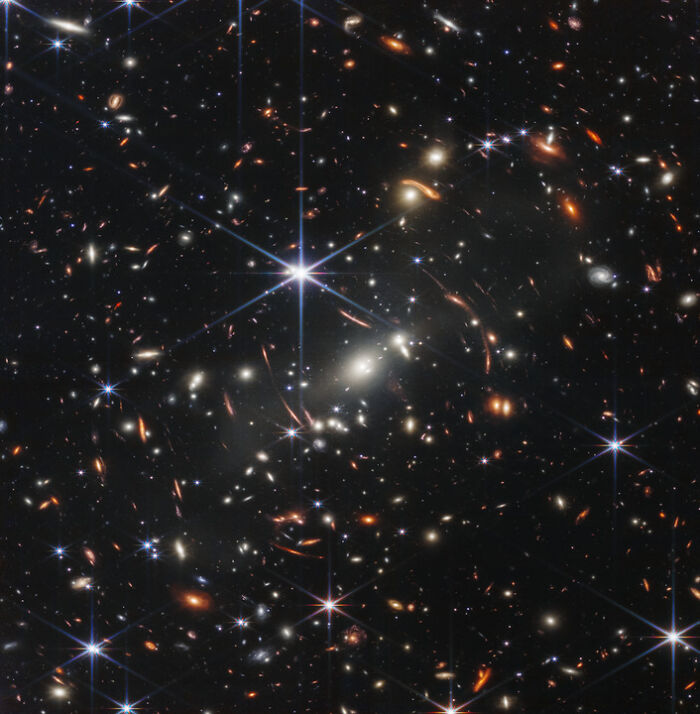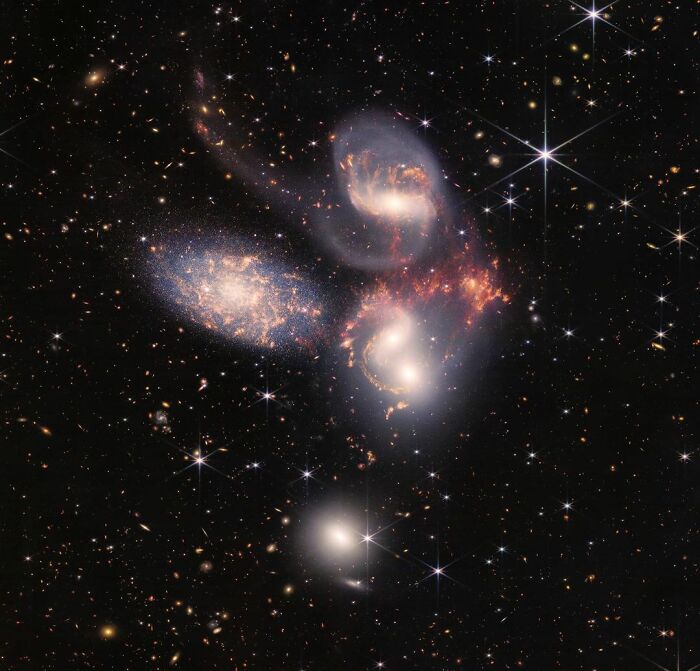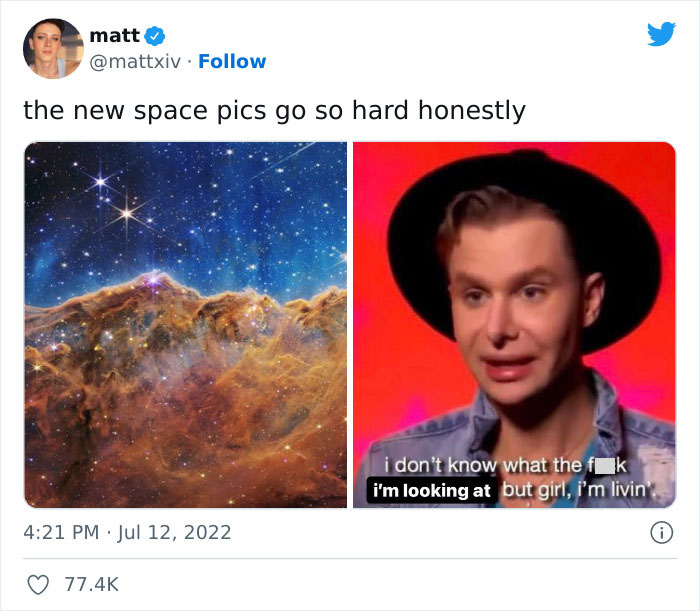
22 People React To The First 5 Images From The James Webb Space Telescope
We keep getting back to what Philip J. Fry of Futurama fame famously once said about space: “Space; It seems to go on and on forever… but then you get to the end and a gorilla starts throwing barrels at you.”
While it applies to the space-themed Monkey Fracas Jr. arcade game (an homage of sorts to Donkey Kong Jr.), it also applies (very much) to space in general. It does seem to go on and on forever.
And to prove that, we now have some space telescope imagery from the Webb Space Telescope. First imagery, mind you.
More Info: Webb Space Telescope
NASA’s James Webb Space Telescope recently provided humanity with some spectacular pictures of things as far as 4.6 billion light-years away
Image credits: NASA
So, if you haven’t been on top of spacey things, there’s this thing called the James Webb Space Telescope (abbreviated JWST). It’s a $10B space telescope created to do infrared astronomy research, and it’s currently the largest optical telescope in space. Its advanced technical capabilities and sensitivity allow for more than what the famous Hubble Space Telescope does—to see things that are too old, too distant, or too faint for the latter.
And it’s been in the news lately as NASA (that awesome space agency in the US) has released unique snaps from the telescope. The images are said to be the deepest view of the universe we live in taken thus far. In other words, we now see much more of the universe than ever before, unveiling the majestic grandeur of space and everything in it. Or how insignificant humanity is in the grand scheme of things. To each their own, you know.
Webb is the scientific successor of the Hubble Telescope and aims to continue rewriting history and identifying humanity’s space in this vast vat of everything
Image credits: NASA
Image credits: NASA
The images in question feature several spectacular views. The main image, titled Webb’s First Deep Field, depicts SMACS 0723, a galaxy cluster 4.6 billion light-years away from us, in the Piscis Volans constellations.
Besides this, we also have the Cosmic Cliffs of Carina. The Carina is another constellation with the Great Carina Nebula, a.k.a NGC 3372, found in the Milky Way 8,500 light-years away from Mother Earth.
Lastly, we have Stephan’s Quintet and the Southern Ring Nebula. The first is a visual grouping of five galaxies found in the Pegasus constellation. Fun fact, four of the five galaxies in this grouping will over time quite likely merge with each other, and if you haven’t seen how that works, it’s hella spectacular, and you’re welcome.
The second is a bright planetary nebula, roughly 2,000 light-years away, that includes two relatively close stars. The central star blew off some steam in the form of 100,000 Kelvins and outer layers, making the nebula brightly fluorescent from all of the ultraviolet radiation. Very deadly. Very beautiful.
Among the pictures, we can see SMACS 0723, The Cosmic Cliffs of Carina, Stephan’s Quintet (pictured below), and the Southern Ring Nebula
Image credits: NASA
Image credits: NASA
Why is this important? Well, learning more about the vast everything that we live in is always important for a number of reasons. NASA puts it best:
“Human space exploration helps to address fundamental questions about our place in the Universe and the history of our solar system. Through addressing the challenges related to human space exploration, we expand technology, create new industries, and help to foster a peaceful connection with other nations.”
The monumental telescope aims to rewrite history and to further identify our place in the universe. And in the long run, your Samsung Galaxy phone will literally be produced using galactic materials once space mining becomes a thing. This is besides the possibility of commercial space travel and the prospects of living on other planets.
The Webb Space Telescope seen below is expected to operate for a minimum of 5 years with the hope that it will continue for over 10 years
Image credits: NASA GSFC/CIL/Adriana Manrique Gutierrez
As you might have guessed, this spawned not only wonder but also loads of jokey reactions and memes from the internet because that’s what it does. You know, “here’s how vast the galaxy is and you still can’t find a girlfriend”, and “considering how vast the universe is, you really think God Almighty is really concerned about your sexual orientation at this point?”
And, it wouldn’t be the internet without some reactions, both of awe and of jokes about how you can’t find a girlfriend despite the universe being so vast
Image credits: JacobThomper
Image credits: Daniel91999
Image credits: 99hitpoints
Image credits: SirNickNite
Image credits: exageradaSA
But there were those who were genuinely in awe at the visual findings. Fun fact, in reality, nebulas and other galactic wonders that we can find in the skies above don’t look like what the pictures show. The original pictures are actually processed—enhance details, add visual, whatnot—because the raw footage is like looking at an ultrasound. A dash of Photoshop provides a better understanding of the celestial objects and, if anything, people are able to appreciate it more because, honestly, just the concept of it all is mind-blowing.
Image credits: ablT315I
Image credits: shaun_vids
Image credits: shannonmstirone
Image credits: mattxiv
Image credits: ParikPatelCFA
Image credits: mattxiv
Image credits: zackkahn
Image credits: sydbricks
Image credits: JillKrajewski
Now, before you go, though, here are some fun facts about the telescope itself, but we’d also love to hear from you in the comment section below. Tell us what you think of the new findings, or what you hope humanity finds in the near future!
Image credits: jlkardon
Image credits: dominicknero
Image credits: SomniumSound
Image credits: electrolemon
Image credits: limitlessjest
Image credits: xuhulk
Image credits: aspiringkrypto
Image credits: coopdiggitydogg
So, fun facts:
– How big is the Webb telescope? The sun shield is 21.2 by 14.2 meters (69.5 by 46.5 feet), while the height of the entire observatory is 8 meters (28 feet). It’s about as wide as a bowling lane is long, and then ¾ of another lane in height.
– How long will the Webb telescope stay in operation in space? It’s designed to perform its duties for a minimum of 5 years, with the goal of exceeding 10 years.
– How is the telescope powered? Like most things we chuck into space, it’s powered by an array of solar panels. It generates about 2,000 watts of electricity (about 1/6th of the average rate of household energy consumption in the US), and there’s also enough propellant on board to last 10 years to make sure the telescope maintains its orbit around the sun.
– How much data does the Webb telescope transmit? It can downlink a minimum of 28 megabits per second or roughly 57 gigabytes of space data per day. In context, the average U.S. internet speed in 2020 was nearly 43 megabits per second.
– So, what is the telescope like on this bad boy? The telescope is equipped with 4 pieces of scientific equipment: the Near-Infrared Camera (NIRCam), the Near-Infrared Spectrograph (NIRSpec), the Near-Infrared Imager and Slitless Spectrograph (NIRISS), and the Mid-Infrared Instrument (MIRI). Each uses infrared detectors to capture light. SCIENCE!
You can find out more on the official Webb Space Telescope website and don’t forget all of their social media like Facebook, Twitter, Instagram, and YouTube.
80Kviews
Share on FacebookTruly spectacular. I can only imagine what even who worked on this must have felt when those first images came through. Bravo!! Now, if only this could inspire us to figure out how not to be such a generally miserable species before we travel out there and wreak the same c**p on other worlds.
No need to worry. We won't survive ourselves long enough to go ruin the galaxy. We MAY be the smartest animal on this little globe but we are definitely still just dumb monkeys that can't stop fighting over land, resources, mates, perceived power, and imaginary dieties. The vast majority of humanity are fear driven dimwits with their heads buried in the past. Fortunately Earth will have time to take another shot at it once our epic failure concludes.
Load More Replies...Stephan’s Quintet looks like a paw, which is scientific proof that cats own the Universe!
Ok jokes aside, this is f*****g cool!! I love engineering and space so like ✨✨
Truly spectacular. I can only imagine what even who worked on this must have felt when those first images came through. Bravo!! Now, if only this could inspire us to figure out how not to be such a generally miserable species before we travel out there and wreak the same c**p on other worlds.
No need to worry. We won't survive ourselves long enough to go ruin the galaxy. We MAY be the smartest animal on this little globe but we are definitely still just dumb monkeys that can't stop fighting over land, resources, mates, perceived power, and imaginary dieties. The vast majority of humanity are fear driven dimwits with their heads buried in the past. Fortunately Earth will have time to take another shot at it once our epic failure concludes.
Load More Replies...Stephan’s Quintet looks like a paw, which is scientific proof that cats own the Universe!
Ok jokes aside, this is f*****g cool!! I love engineering and space so like ✨✨

 Dark Mode
Dark Mode 

 No fees, cancel anytime
No fees, cancel anytime 














































































160
28